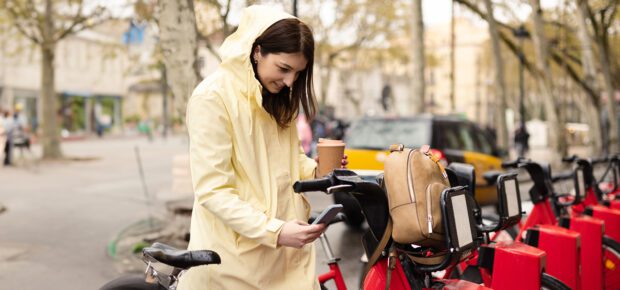October 3, 2024
The number of bike-sharing programs has exploded in large cities over the past decade. Of the 20 largest cities in the world, the vast majority have bike-sharing systems.
In all, there are at least 2,000 bike-sharing programs worldwide, according to the Bike-Sharing World Map. These programs have been bolstered by the addition of e-bikes and e-scooters, which often get labeled together using the term shared micro-mobility.
The growth in bike-sharing programs could reduce traffic congestion in urban centers. Encouraging people to use them could also reduce greenhouse gas emissions if they choose micro-mobility over a trip in an automobile.
Besides being too lazy to walk, what makes people participate in a shared bike program when they have other options, like cars or public transportation?
Choosing Bike Share
A significant amount of research has already been done on the factors driving bike share use, looking at factors that include demographics, the perception of safety, weather, access to public transportation and distance.The studies have found that the likelihood of using micro-mobility was highest for travels to universities or colleges and sporting events.
One study of Zurich’s shared micro-mobility services found that users are typically young, male, university-educated professionals who are gainfully employed and live in affluent single-person households without children or cars.
Bored with Cars? Try an E-Bike
While research into the use of bike sharing programs is fairly robust, many of the studies don’t take into account the rise of electric bicycles and users’ choices between e-scooters, e-bike and regular bicycles. A recent article in IEEE Access explores those choices.
The research, which focused on users in Budapest, found that people preferred traditional bicycles over e-bicycles by a slim margin and e-bikes over electric scooters. The highest likelihood of switching from a conventional bicycle to an e-bike occurred when travel time or travel distance increased by 20%
One group showed a consistent preference for e-bikes: people that owned cars.
The most common reason to use the system was leisure, rather than a trip to work or school.
Safety A Factor
When bicycles travel on roads, they often do so alongside cars, which likely acts as a deterrent to increased use of bikes in urban environments.
“Cities can improve safety by designing dedicated bicycle lanes and e-scooter lanes to keep cyclists and e-scooter users away from motor vehicle lanes,” said IEEE Fellow Guoliang Xing.
IEEE Member Bilin Aksun-Guvenc said that integrating micro-mobility use with public transit adoption could also increase adoption. “Seamless integration of public transportation with microtransit in the form of bicycles (including electric ones) and e-scooters will increase their useful range,” Aksun-Guvenc said.
This means that it should be easy to carry your bicycle and e-scooter on public buses, trains and subways.”





 Meaningful Momentum or Running in Place?
Meaningful Momentum or Running in Place? AI Through Our Ages
AI Through Our Ages Liquid Infrastructure: Our Planet's Most Precious Resource
Liquid Infrastructure: Our Planet's Most Precious Resource The Impact of Technology in 2025
The Impact of Technology in 2025 Quantum and AI: Safeguards or Threats to Cybersecurity?
Quantum and AI: Safeguards or Threats to Cybersecurity? Why AI Can't Live Without Us
Why AI Can't Live Without Us Bits, Bytes, Buildings and Bridges: Digital-Driven Infrastructure
Bits, Bytes, Buildings and Bridges: Digital-Driven Infrastructure Impact of Technology in 2024
Impact of Technology in 2024 Emerging AI Cybersecurity Challenges and Solutions
Emerging AI Cybersecurity Challenges and Solutions The Skies are Unlimited
The Skies are Unlimited Smart Cities 2030: How Tech is Reshaping Urbanscapes
Smart Cities 2030: How Tech is Reshaping Urbanscapes Impact of Technology 2023
Impact of Technology 2023 Cybersecurity for Life-Changing Innovations
Cybersecurity for Life-Changing Innovations Smarter Wearables Healthier Life
Smarter Wearables Healthier Life Infrastructure In Motion
Infrastructure In Motion The Impact of Tech in 2022 and Beyond
The Impact of Tech in 2022 and Beyond Cybersecurity, Technology and Protecting Our World
Cybersecurity, Technology and Protecting Our World How Technology Helps us Understand Our Health and Wellness
How Technology Helps us Understand Our Health and Wellness The Resilience of Humanity
The Resilience of Humanity Harnessing and Sustaining our Natural Resources
Harnessing and Sustaining our Natural Resources Creating Healthy Spaces Through Technology
Creating Healthy Spaces Through Technology Exceptional Infrastructure Challenges, Technology and Humanity
Exceptional Infrastructure Challenges, Technology and Humanity The Global Impact of IEEE's 802 Standards
The Global Impact of IEEE's 802 Standards Scenes of our Cyber Lives: The Security Threats and Technology Solutions Protecting Us
Scenes of our Cyber Lives: The Security Threats and Technology Solutions Protecting Us How Millennial Parents are Embracing Health and Wellness Technologies for Their Generation Alpha Kids
How Millennial Parents are Embracing Health and Wellness Technologies for Their Generation Alpha Kids Space Exploration, Technology and Our Lives
Space Exploration, Technology and Our Lives Global Innovation and the Environment
Global Innovation and the Environment How Technology, Privacy and Security are Changing Each Other (And Us)
How Technology, Privacy and Security are Changing Each Other (And Us) Find us in booth 31506, LVCC South Hall 3 and experience the Technology Moon Walk
Find us in booth 31506, LVCC South Hall 3 and experience the Technology Moon Walk Virtual and Mixed Reality
Virtual and Mixed Reality How Robots are Improving our Health
How Robots are Improving our Health IEEE Experts and the Robots They are Teaching
IEEE Experts and the Robots They are Teaching See how millennial parents around the world see AI impacting the lives of their tech-infused offspring
See how millennial parents around the world see AI impacting the lives of their tech-infused offspring Take the journey from farm to table and learn how IoT will help us reach the rising demand for food production
Take the journey from farm to table and learn how IoT will help us reach the rising demand for food production Watch technical experts discuss the latest cyber threats
Watch technical experts discuss the latest cyber threats Explore how researchers, teachers, explorers, healthcare and medical professionals use immersive technologies
Explore how researchers, teachers, explorers, healthcare and medical professionals use immersive technologies Follow the timeline to see how Generation AI will be impacted by technology
Follow the timeline to see how Generation AI will be impacted by technology Learn how your IoT data can be used by experiencing a day in a connected life
Learn how your IoT data can be used by experiencing a day in a connected life Listen to technical experts discuss the biggest security threats today
Listen to technical experts discuss the biggest security threats today See how tech has influenced and evolved with the Games
See how tech has influenced and evolved with the Games Enter our virtual home to explore the IoT (Internet of Things) technologies
Enter our virtual home to explore the IoT (Internet of Things) technologies Explore an interactive map showcasing exciting innovations in robotics
Explore an interactive map showcasing exciting innovations in robotics Interactively explore A.I. in recent Hollywood movies
Interactively explore A.I. in recent Hollywood movies Get immersed in technologies that will improve patients' lives
Get immersed in technologies that will improve patients' lives